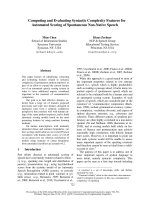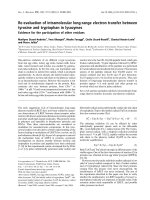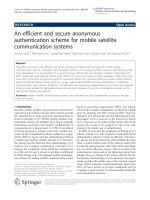- Trang chủ >>
- Mầm non - Tiểu học >>
- Lớp 1
An Adaptive and Wide-Range Output DC-DC Converter for Loading Circuit of Li-Ion Battery Charger
Bạn đang xem bản rút gọn của tài liệu. Xem và tải ngay bản đầy đủ của tài liệu tại đây (1.05 MB, 9 trang )
<span class='text_page_counter'>(1)</span><div class='page_container' data-page=1>
10
An Adaptive and Wide-Range Output DC-DC Converter
for Loading Circuit of Li-Ion Battery Charger
Nguyen Van Hao, Nguyen Duc Minh, Pham Nguyen Thanh Loan
*<i>BKIC Lab, School of Electronics and Telecommunications, </i>
<i>Hanoi University of Science and Technology, Hanoi, Vietnam </i>
<b>Abstract </b>
In this paper, an adaptive and wide-range output DC-DC converter designed for lithium-ion (Li-Ion) battery
charger circuit is proposed. The converter operates in continuous conduction mode (CCM) to provide an output
voltage in response to battery voltage and a wide-range output current to ensure that circuit requirements are
met. This circuit is designed on Cadence using 0.35-m BCD technology. Simulation results show that the
circuit fully operates in CCM mode with a load current from 50 mA to 1000 mA and output voltage ripple factor
is less than 1 %. Furthermore, the current supplied to the load circuit responses to three types of Li-Ion
rechargeable currents. The output voltage of the converter varies from 2.8 to 4.5 V corresponding to the voltage
range of the battery being charged from 2.5 to 4.2 V. The average power efficiency of the converter in large load
current mode (1000 mA) reaches 94 %.
Received 12 April 2018, Revised 18 June 2018,Accepted18 June 2018
<i>Keywords: Li-Ion battery, charging mode, charger circuit, DC-DC converter, adaptive reference voltage. </i>
<b>1. Introduction</b>
Today, Li-Ion batteries are widely used in
consumer electronics for its significant
advantages such as high energy density, high
recharge cycle (> 1000 cycles), no memory
effect, low self-discharged rate (2 - 8 % per
month), wide range of operating condition
(charge at –20 – 60 C, discharge at -40 - 65
C). In addition, a single cell of Li-Ion battery
can operate in the range of 2.5 to 4.2 V [1]. The
charging circuit is designed according to three
modes following the charging standard [2, 3] as
_______
Corresponding author.
shown in figure 1. Trickle constant current
mode (TC) occurs when the battery voltage is
less than 2.9 V, large constant current mode
(LC) when the battery voltage is in the range of
2.9 to 4.2 V, and constant voltage charging mode
(CV) when the battery voltage reaches
4.2 V.
</div>
<span class='text_page_counter'>(2)</span><div class='page_container' data-page=2>
Figure 1. Li-Ion battery charging modes.
The switching mode power supply
converter is used to generate a variable supply
voltage changing in response to the battery
voltage during the charging process. However,
the use of large off-chip elements for the boost
converter structure in [7] and the flyback
converter in [8] increase the size of printed
circuit board (PCB). The rechargeable circuit in
[9, 10] adopted the buck converter structure
minimizing the size of PCB. However, the TC
charging mode was not introduced and there
was no isolation between DC-DC converter and
battery so the self-discharge of battery may
occur and battery performance cannot be
guaranteed. In this article, we propose an
adaptive buck DC-DC converter based on a
buck converter structure that operates in
continuous conduction mode (CCM) with a
wide range of voltage and current variations in
accordance with the Li-Ion charging circuit that
was presented in our previous work [11].
The rest of the paper is structured as
follows: Section 2 describes the structure of an
adaptive and wide-range output DC-DC
converter with a battery charger as load. Design
parameters are considered and calculated in
Sub-Section 2 to ensure that the converter
wide range of voltage and current to the load
circuit. In Section 3, the simulation results are
shown to evaluate the converter’s performance.
Finally, the conclusion is given in Section 4.
<b>2. Circuit descriptions </b>
In general, the PWM DC-DC converter, as
shown in figure 2, is implemented to provide a
stable output voltage VO from the input voltage
VI thanks to the closed loop control. The
feedback voltage VFB is sampled from the
output through a voltage divider of two resistors
RF1, RF2. In the compensator, the VFB will be
compared with the reference voltage VARV to
generate the deviation voltage VC which is used
to determine the duty cycle of VPWM from the
PWM generator circuit. The switching signals
VN, VP to the gate of two power MOSFET N
and P are finally generated by the non-overlap
gate driver. The output filter LCO is well chosen
to stabilize the output voltage that can be
determined as follows (1)
ARV
2
F
2
F
1
F
O V
R
R
R
V <sub></sub>
<sub>(1) </sub>
Besides, the load of this DC-DC converter
is a Li-Ion battery charging circuit which has
been implemented in [11]. In that previous
work, the varying battery voltage VBat during
the charging process is fed into the voltage
level-shift circuit to provide a variable reference
voltage VARV, which is also called an adaptive
reference voltage. The DC-DC converter’s
output voltage VO should also be controlled to
follow the battery voltage VBat so that the power
efficiency of the whole system is improved. In
this design, the value of the input voltage VI is.
around 6 V, switching frequency FSW is selected
at 500 KHz and the output voltage VO of the
converter is expected to be always 0.3 V higher
than the battery voltage VBat.
</div>
<span class='text_page_counter'>(3)</span><div class='page_container' data-page=3>
Figure 2. Structure of adaptive DC-DC converter with Li-Ion battery charger as load.
<i><b>2.1. Compensator </b></i>
To ensure the current and voltage
requirements to the load circuit, the analysis of
a conventional buck converter presented in [12]
is employed to determine the value of inductor
L and the ceramic capacitor CO. The theoretical
calculation pointed out that the corresponding
values of inductor and capacitor should be 22
H (RL 46 m) and 22 F (RC 5 m)
respectively. The transfer function of power
converter stage is thus defined as a function of
double-pole LC (7.23 KHz) generated by the
LCO filter and one zero ESR (1.45 MHz)
created by the equivalent series resistance RC
andCO. To stabilize the circuit and compensate
the phase degradation caused by the
double-pole, the type-III compensation is adopted as
shown in figure 3. Error amplifier EA is
designed using a class AB two-stage op-amps
with high and symmetrical slew rate [13].
Transfer function of the compensation circuit
given in (2) consists of three poles (P0, P1,
P2) and two zeros (Z1, Z2). The zero
frequency ESR is much larger than the
switching frequency SW so that it does not
affect the frequency range of the converter. In
this approach, zero frequencies Z1 and Z2 are
designed in adjacent to the double-pole at
frequencies 0.6LC and 1.5LC respectively.
Pole frequency P1 is set at 0.5SW and P2 is
calibrated in frequency range of (0.8 – 0.9)SW.
<sub></sub>
<sub></sub>
2
P
1
P
2
Z
1
Z
3
2
1
F
C
s
1
s
1
s
1
s
1
s
1
C
C
R
1
s
K (2)
With,
3
2
3
2
2
2
P
1
1
1
P
0
P
C
C
C
C
R
1
,
C
R
1
,
0
1 F1
1
2
Z
2
2
1
Z
R
R
C
1
,
C
R
1
</div>
<span class='text_page_counter'>(4)</span><div class='page_container' data-page=4>
<b>Resistors Parameters </b> <b>Capacitors Parameters </b>
RF1, R<b>F2 </b> 13 K C<b>1 </b> <b>1100 pF </b>
R<b>1 </b> 566 C<b>2 </b> <b>510 pF </b>
R<b>2 </b> 71.5 K C<b>3 </b> <b>5.1 pF </b>
Figure 4. Bode plot of the converter’s loop gain
for VO = 4 V and IO = 1 A.
From (2), the design values of the
compensation network components are
calculated and summarized in table 1. The
phase margin and gain margin in figure 4
demonstrated a loop gain of converter ~ 59.4
deg at cross frequency 54 KHz and 27 dB at
frequency 445 KHz.
<i>2.2. PWM generator </i>
In figure 5(a), the high-speed comparator is
used [14] to provide pulse width modulator
(PWM) signals. As mentioned above, the signal
VC is compared to ramp signal VR at fixed
amplitude and frequency to produce the pulse
as in (3). The waveforms of VC, VR and VPWM
are illustrated in figure 5(b). The PWM circuit
functions correctly as expected through the loop
control and it is able to regulate the output
voltage of DC-DC converter.
R
C
I
O
V
V
D
V
V
<sub>(3) </sub>
Figure 5. (a) PWM generation circuit.
(b) Corresponding signals.
<i><b>2.3. Ramp generator </b></i>
The schematic of a ramp generator is shown
in figure 6(a). The reference current IB is
created and controlled by reference voltage VRef
as a current source. The topology of
low-voltage cascode current mirror is used to create
the currents IR and ICh. The reference voltages
VH and VL are then created by the flow of
current IR through two resistors RH and RL in
series. The ramp signal is produced by the
charging and discharging of the capacitor CR. In
steady state, when VL < VR < VH, the transistors
M10 – M12 are OFF, the reference voltage VH is
</div>
<span class='text_page_counter'>(5)</span><div class='page_container' data-page=5>
comparator. The capacitor CR is then charged
during this period until the voltage VR is higher
than VH. That will turn the transistors M10 – M12
ON so the reference voltage is switched to VL.
The capacitor CR is discharged rapidly, the
voltage VR is reduced to a value smaller than
VL that turn the transistors M10 – M12 to OFF
state. The process is then repeated. The period
of ramp signal is calculated as a function of the
charging time (Trise) as expressed in equation
(4) and the discharging time (Tfall) of the
capacitor CR. The ratio of Tfall/Trise is
approximately of 5 % that lead to a discharging
time Tfall of about 100 ns.
R
H
Ch
R
H
R
Ch
R
L
H
rise R C
I
C
R
I
I
C
V
V
T
<sub>(4) </sub>
As can be seen in equation (4), the value of
ramp frequency is a function of RH and CR. To
ensure the performance of ramp generator, a
high gain OA [15] with loop gain stability is
adopted. The high speed comparator C is
designed with a propagation delay of about 10
ns that is suitable for our adaptive-output
converter. Simulations of ramp generator is
presented in figure 6(b). It can be seen that
ramp signal VR meets the maximum value at
3.51 V and minimum value at 0.45 V where the
operating signal reaches 500.5 KHz
as expected.
<i><b>2.4. Non-overlap and Gate Driver </b></i>
The non-overlap and gate driver circuit are
illustrated in figure 7(a). The gate driver is a
buffer circuit consisting of four inverter layers
designed according to the tapering factor in the
range of 3 to 4 [14]. The gate driver is used to
switch the power transistors MP and MN of
DC-DC converter to obtain a certain output
voltage level defined by the duty cycle of
switching control signal VPWM. In addition, to
avoid power loss induced at each switching
transition when both MP and MN are open
resulting in shoot-through current loss, the
non-overlap circuit is also implemented. A sufficient
small delay between the rise time and fall time
of two opposite VP and VN signals is added.
Their waveforms are presented in figure 7(b).
K
</div>
<span class='text_page_counter'>(6)</span><div class='page_container' data-page=6>
(b)
Figure 6. (a) Ramp generation circuit. (b) Waveform of ramp signal.
Figure 7. (a) Non-overlap and gate driver. (b) Corresponding output waveforms.
<b>3. Simulation results </b>
The inductor current and output voltage of
the proposed DC-DC converter are shown in
figure 8. It is obvious that the continuous
conduction mode is guaranteed for three
different operation modes of battery charging
circuit playing the role as load of the converter.
The average inductor current, also called as the
load current, reaches the value of 200 mA at
output voltage of 3 V, 1000 mA with output
voltage of 4 V and 50 mA with output voltage
of 4.5 V, respectively. These results confirm
that the circuit meets the requirement of power
supply for battery charging circuit while it
works at trickle charging mode (TC), large
current charging mode (LC) and constant
voltage charging mode (CV) respectively.
Besides, the output voltage ripple is relatively
small and almost lower than 1 %.
</div>
<span class='text_page_counter'>(7)</span><div class='page_container' data-page=7>
whole system. At light load, when the load
current is less than 50 mA, the converter
gradually switches to DCM mode, that results
in power loss. But this problem can be
improved by a detecting-negative-current
circuit from the inductor current of the power
stage. In addition, a slight undershoot voltage at
the transition from trickle to large current mode
is also observed in figure 9(b). However, an
undershoot voltage of 60 mV which is about 1.8
% of output voltage can be neglected.
Interestingly, a constant 0.3 V difference
between the output voltage VO of the proposed
DC-DC converter and the battery is recorded
for three different charging modes. The
converter's output voltage is always 0.3 V
higher than the battery voltage. It is seen that
VO is adjusted dynamically according to the
battery voltage with the accuracy of over 99 %.
As per its name, this DC-DC converter provides
an adaptive power supply, not a constant output
voltage like any other conventional DC-DC
converter, to the battery charger circuit.
As can be observed in figure 10, the power
efficiency of our proposed adaptive-output
converter is higher than 94 % for an output
voltage varying widely from 2.8V to 4.5 V. The
highest efficiency can be reached at 97 % where
output voltage varies from 2.8 to 3.2 V and load
current is 200 mA. Efficiency is 94 % with an
output voltage varying from 3.2 V to 4.5 V
where load current is 1000 mA.
(a) Corresponding to TC mode of the battery charger
(b) Corresponding to LC mode of the battery charger
(c) Corresponding to CV mode of the battery charger
Figure 8. Steady-state waveforms of inductor current
and output voltage with.
(a) IO = 0.2 A, VO = 3.0 V. (b) IO = 1 A, VO = 4.0 V.
(c) IO = 50 mA, VO = 4.5 V.
(a)
(b)
Figure 9. Simulation results of adaptive DC-DC
converter with Li-Ion battery charger load.
(a) Output current.
</div>
<span class='text_page_counter'>(8)</span><div class='page_container' data-page=8>
Figure 10. Power efficiency of adaptive DC-DC
converter with versus output voltage.
<b>4. Conclusion </b>
An adaptive and wide-range output DC-DC
converter for the Li-Ion battery charger circuit
is proposed and designed on the 0.35 m BCD
technology. The converter operating in CCM
mode offers a wide range of load current from
50 mA to 1000 mA as well as a broad range of
voltage output (from 2.8 to 4.5 V) to the load
circuit. The output current and voltage profile
of the proposed converter meets perfectly the
requirements for Li-Ion battery charger circuit.
An average power efficiency of 94 % obtained
for the crucial stage of large-current charging
mode (1000 mA). As a continuation to our
previous work, this circuit helps to complete a
charging system from power line DC to a
Li-Ion battery by combining with the battery
charger in [11].
<b>Acknowledgements </b>
This research was supported by Prof. Lee
Sang-Guk, NICE lab, KAIST, Korea.
<b>References </b>
[1] D. Linden, and T. B. Reddy, Handbook of
batteries, ch. 35, pp. 35.2, New York:
McGraw-Hill, 2002.
Mag., pp. 40-49, Apr. 2005.
[3] A. A. Hussein and I. Batarseh, "A review of
charging algorithms for nickel and lithium battery
chargers," IEEE Trans. Veh. Tech., vol. 60, no. 3,
pp. 830-838, Mar. 2011.
[4] C.-C. Tsai, C.-Y. Lin, Y.-S. Hwang, W.-T. Lee,
T.-Y. Lee, "A multi-mode LDO-Based Li-Ion
battery charger in 0.35-mm CMOS technology,"
IEEE Asia-Pacific Conf. Circuits Syst., 2004, pp.
49-52.
[5] C. C. Tsai, C. Y. Lin, Y. S. Hwang and T. Y. Lee,
"The design of a Li-Ion battery charger based on
multimode LDO Technology," Journal of
Circuits, Systems and Computers, vol. 18, no. 05,
pp. 947-963, 2009.
[6] Hieu M. Nguyen, Lam D. Pham and Trang
Hoang, "A novel Li-Ion battery charger using
multi-mode LDO configuration based on 350 nm
HV-CMOS," Analog Integrated Circuits and
Signal Processing, vol. 88, issue 3, pp. 505-516,
Jun. 2016.
[7] M. Chen and G. A. Rincón-Mora, "Accurate,
compact, and power-efficient Li-Ion battery
charger circuit," IEEE Trans. Circuits Syst. II,
Exp. Briefs, vol. 53, no. 11, pp. 1180-1184,
Nov. 2006.
[8] J. Chen, F. Yang, C. Lai, Y. Hwang and R. Lee,
"A high-efficiency multimode Li-Ion battery
charger with variable current source and
controlling previous state supply voltage," IEEE
Trans. Ind. Electron., vol. 56, no. 7,
pp. 2469-2478, Jul. 2009.
[9] R. Pagano, M. Baker and R.E. Radke, "A 0.18-μm
monolithic Li-Ion battery charger for wireless
devices based on partial current sensing and
adaptive reference voltage," IEEE J. Solid-State
Circuit, vol. 47, no. 6, pp. 1355-1368, Jun. 2012.
[10] T. C. Huang, R. H. Peng, T. W. Tsai, K. H. Chen
and C. L. Wey, "Fast charging and high efficiency
switching-based charger with continuous built-in
resistance detection and automatic energy deliver
control for portable electronics," IEEE Journal of
Solid-State Circuits, vol. 49, no. 7, pp. 1580-1594,
Jul. 2014.
</div>
<span class='text_page_counter'>(9)</span><div class='page_container' data-page=9>
[12] Byungcho Choi, Pulsewidth modulated DC-to-DC
power conversion: circuits, dynamics, and control
designs, John Wiley & Sons, 2013.
[13] J. Aguado-Ruiz, A. Martin, J.
Lopez-Lemus and J. Ramirez-Angulo, "Power Efficient
Class AB Op-Amps With High and Symmetrical
Slew Rate," IEEE Transactions on Very Large
Scale Integration (VLSI) Systems, vol. 22, no. 4,
pp. 943-947, Apr. 2014.
[14] Cheung Fai Lee and P. K. T. Mok, "A monolithic
current-mode CMOS DC-DC converter with
on-chip current-sensing technique," IEEE Journal
of Solid-State Circuits, vol. 39, no. 1, pp. 3-14,
Jan. 2004.
</div>
<!--links-->









